
Where do our carbohydrates come from? What is the ethical implications of grain culture?
The picture above says it all.
I have reduced my fossil fuel consumption as practically possible at this time, I minimize my use of paper products, and avoid heavily packaged products and I have an overly productive greens gardens in a region of Canada that has surplus apples and shell fish. By most accounts I live a relatively sustainable lifestyle. Or do I?
I still rely on the tillage agriculture, organic or otherwise, for my supply of bulk carbohydrates. And when it really comes down to it deforestation and industry are a bad second and third place in environmental damage when stacked up beside tillage grain and grain legume production.
By all accounts the soil loss and desertification created by tillage grain culture are the most destructive activities on the planet.
My next personal ethical frontier is extricating myself from the need for tillage grain culture.
So after the sad little failure in an attempt to attain carbohydrate sovereignty. We went back to the drawing board and to our closest permaculture colleagues for advice on a not so labour intensive method of getting a great yield of potatoes. A lot of the old timers suggest digging down to plant and hilling soil up twice through the growing season. This would be great if we had some space already prepared.
All we have is lawn and after last years painful experience we did not want to dig for potatoes this year. What we want to demonstrate is that our bulk supply of carbohydrates can be gotten with a minor amount of physical input, while simultaneously building a healthy soil system. It is an easy thing to grow enough salad greens and tomatoes. It is a whole other project to provision ourselves with enough raw carbohydrate energy.
We have also heard great things about potatoes in mulch beds and mixed reviews on the potato mulch tower. So we with that we have chosen to go with a potato sheet mulch over some old sod on some rough soil and see what happens.
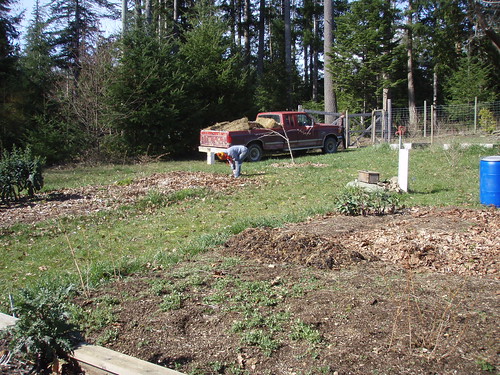 We are working with the strip of sod located between the two garden beds in the photo. Not only are we trying to grow potatoes, we are using this planting approach to pioneering the system out of grass and into fertile loose garden beds with health soil structure. A Much better approach than digging, if it works.
We are working with the strip of sod located between the two garden beds in the photo. Not only are we trying to grow potatoes, we are using this planting approach to pioneering the system out of grass and into fertile loose garden beds with health soil structure. A Much better approach than digging, if it works.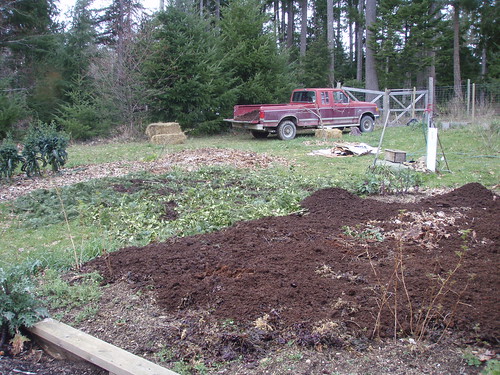 We recently cut down a few fir trees that where to close to the house. Not wanting to burn the branches and slash from the trees, we processed it up with a machete and used it as our bottom layer in the sheet mulch along with kitchen scraps, last year 'scompost pile and a heap of well composted horse manure.
We recently cut down a few fir trees that where to close to the house. Not wanting to burn the branches and slash from the trees, we processed it up with a machete and used it as our bottom layer in the sheet mulch along with kitchen scraps, last year 'scompost pile and a heap of well composted horse manure.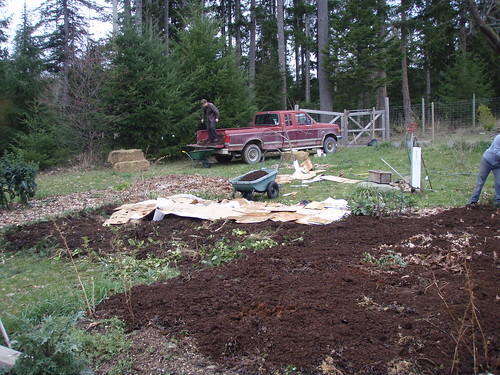 The next layer to go down was, of course, cardboard we did our best to soak this down. It is really important to soak the cardboard well, as it will suck moisture our of the soil if it dries out. I find that it works best to be able to dunk it and let it sit in water. A near by ditch pond or small kiddie pool will work well. In this case we where without those features, fortunately it was still March on the west coast of Canada so rain is great supply. The night we did this it rained about 3omm so the cardboard got a good soaking. It is also critical to keep the cardboard under at least 15cm of mulch to avoid having it dry out.
The next layer to go down was, of course, cardboard we did our best to soak this down. It is really important to soak the cardboard well, as it will suck moisture our of the soil if it dries out. I find that it works best to be able to dunk it and let it sit in water. A near by ditch pond or small kiddie pool will work well. In this case we where without those features, fortunately it was still March on the west coast of Canada so rain is great supply. The night we did this it rained about 3omm so the cardboard got a good soaking. It is also critical to keep the cardboard under at least 15cm of mulch to avoid having it dry out.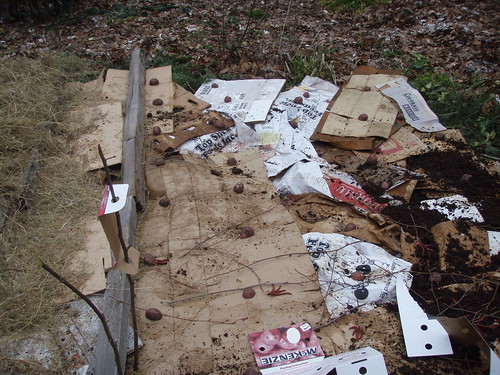 Next came the potatoes. Nothing fancy here just place them at recommended spacing right on top of the cardboard. the roots know what to do. As long as the bed stays, moist the plants will find what they need, easily penetrating the cardboard down to the soil.
Next came the potatoes. Nothing fancy here just place them at recommended spacing right on top of the cardboard. the roots know what to do. As long as the bed stays, moist the plants will find what they need, easily penetrating the cardboard down to the soil.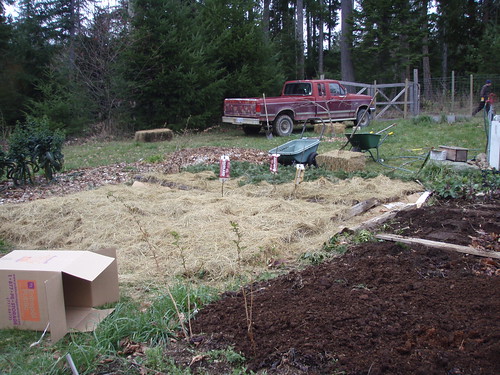 A thick layer of moldy hay and a finishing layer of fir branchlets and we have a finished sheet mulch potato bed. All told it was about 6 hours of people power and not a sing scoop of soil was turned over. My back didn't even know it had done any work. As the potatoes grow we will add more mulch, it is the same as hilling your potatoes in a bare soil bed. The idea being that in the extra mulch depth the potatoes will grow more tubers. Even if we get poor yields, comparable to last years crop, this sure beats the 4 days of back breaking hand tilling we did for last years meager crop. We will keep you posted as it turns out.
A thick layer of moldy hay and a finishing layer of fir branchlets and we have a finished sheet mulch potato bed. All told it was about 6 hours of people power and not a sing scoop of soil was turned over. My back didn't even know it had done any work. As the potatoes grow we will add more mulch, it is the same as hilling your potatoes in a bare soil bed. The idea being that in the extra mulch depth the potatoes will grow more tubers. Even if we get poor yields, comparable to last years crop, this sure beats the 4 days of back breaking hand tilling we did for last years meager crop. We will keep you posted as it turns out.




No comments:
Post a Comment